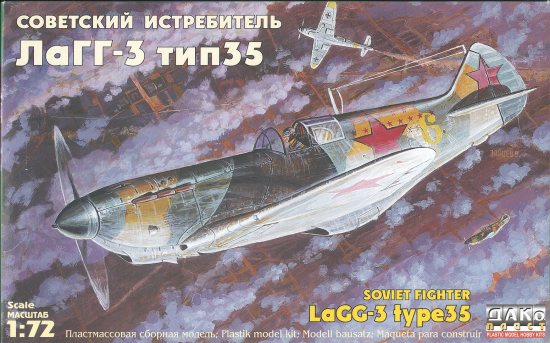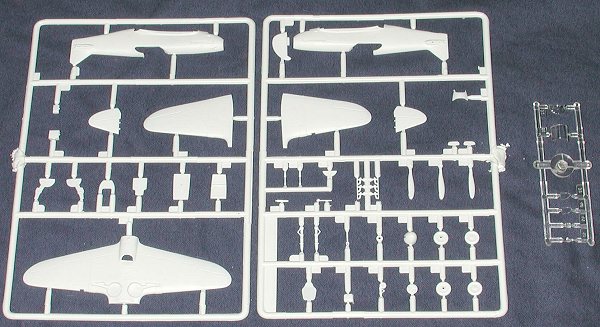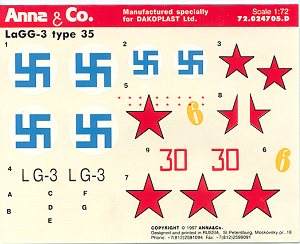
|
KIT: |
Dako 1/72 Lagg-3 Series 35 |
|
KIT # |
12002 |
|
PRICE: |
CDN $9.98 |
|
DECALS: |
3 aircraft |
|
REVIEWER: |
Scott Van Aken IPMS C5729 |
|
NOTES: |

|
HISTORY |
LaGG stands for Lavochkin, Gorbunov and Gudkov. Prior to this aircraft, only Lavochkin had ever designed a plane. Primary material for the LaGG fighter was a material called Delta. It was a sandwich of layers of birch strips which were glued cross-grained, impregnated with glue and used with bakelite plies. This was mainly because the Soviet Union was rather deficient in aluminum so anything that could be used to replace it was highly sought.
The first plane from this design shop was the I-22. There was much expected from it as it was an exceptionally clean design and powered by a Klimov M-105P engine of 1,050 hp. However, due to the large amount of wood in its construction, it was about 600-700 lbs heavier than the mostly aluminum competitor from Yakovlev and his I-26. However, the I-22 met requirements and was moved ahead for further development.
Since greater range than the 370 miles of the I-22 were desired, the I-301 had wing tanks installed that increased the range. It managed to reach a speed of 312 mph at ground level and 376 mph at 16000 feet, making it faster than the Yak I-26 at altitude. During this time (1940) the Soviets received several Bf-109E-3 aircraft and the I-301 was tested against it. It was found that the I-301 outperformed it at altitude and also was more maneuverable. A production order was initiated in mid 1940 as it was obvious to the Kremlin that it was but a matter of time before they would be at war with Germany.
At the time of the German invasion in June of 1941, there were 322 Lagg-3 fighters available to Soviet forces. The majority of these were the series 1. They had an armament of three 12.7mm guns and two 7.62 mm versions in the nose. One of the 12.7mm guns fired through the engine and out the spinner. The exhaust had been lengthened over that of the very similar I-301 prototype. It also had a radio antenna mast and an external rudder balance on the top and bottom of the rudder. Frankly, the radio was a waste as rarely were there many available and then they rarely worked! The Series 1 also had a larger tail wheel. The Series 5 had a 20mm cannon in the nose and the lower rudder balance weight removed. The Series 11 had the 7.62mm guns deleted and was also equipped with under wing bomb and rocket racks.
The next major variant was the Series 35. It incorporated a number of changes to improve the flying qualities of the aircraft. Most pilots found the plane difficult to fly. It not only tended to go nose up on approach, but stalled rather easily. Not exactly a confidence builder. To counter this tendency, automatic slats were fitted. On these aircraft, the pitot tube was relocated to under the wing vice in the leading edge. Later batches had a larger spinner and the radiator was made larger and squared off. It also reintroduced a retractable tail wheel, an item not present on previous aircraft. These aircraft also had an exhaust consisting of three stacks on each side that replaced the single collector of the earlier versions. At least one of this series was captured by the Finns and used as LG-3.|
THE KIT |

When given the opportunity to review this kit, I jumped at the chance as I had the Toko/Roden series 35 kit and wanted to see how they compared. Well, they are not the same, I can tell you that. Dako's kit is in a softish white plastic. Dako has taken the single sprue when it came out of the mold, heated the central chunk and folded it in two. A novel way to keep the parts from rubbing against each other and being damaged or broken. Then then stuck the clear bits in between them and that secured them pretty well.
The overall detailing is actually quite good. It is finely engraved with reasonably well done fabric on the control surfaces. The surface of the plastic itself is very slightly rough, but should disappear under a coat of paint. Almost no flash, no sink areas and no ejector pins in embarrassing locales. There are wheel wells, though the seem a bit shallow and there is no detail in them. Overall, I'd have to say that the detail is more subdued than on the Roden kit, which isn't necessarily a bad thing.
Comparing some of the major parts between the two, the Roden kit has a longer wingspan and the Dako wings are broader. The Dako fuselage is longer with the additional length being aft of the cockpit. Tailplanes are pretty close to being the same. Now I'm not sure which is right and which isn't as they could well both be off, but there is a difference. I doubt if it will engender a storm of controversy as did the Hasegawa 1/48 Spitfire!
There are no optional parts nor under wing drop tanks or rockets provided for the kit. The canopy is of separate parts so I'd assume that one can display it open, but that is no always the case. The clear bits are fairly thin, but the plastic is somewhat distorted so any interior detail will not be easy to see with the canopy closed. The interior itself is rather simple consisting of but a seat, stick, floor and back plates. The instrument panel is fair with separate dials, but little else. There is some detailing on the interior fuselage walls that is also fairly simple but should be effective when painted and detailed.
Other items are that it has the proper retractable tail wheel for a series 35 as well as the proper exhaust, rudder, wings with slats and repositioned pitot. The prop has separate blades (which I could do without) that fit on a backing plate and a separate hub. In all, the kit is not at all complicated and should be a rapid build.
 Instructions are a single folded sheet of newsprint-like paper. One side has the
7 construction steps and color chart with Humbrol numbers and generic color
names. The other side has the history, required warnings (don't eat the parts),
and the camo/decal markings guide.
Instructions are a single folded sheet of newsprint-like paper. One side has the
7 construction steps and color chart with Humbrol numbers and generic color
names. The other side has the history, required warnings (don't eat the parts),
and the camo/decal markings guide.
There are three aircraft possible with the kit decals. One is white 6 flown by G.A.Grigoriev of the 178 IAP in Ocre and Brown over Aircraft Blue. This aircraft has many kill markings on the aft fuselage and is depicted on the box art. Next is red 30 of the 3rd Guards Regiment. It is colored Matte Black and Dark Green upper with Aircraft Blue undersides, this is thinly covered by a white temporary finish. Finally, a captured Finnish version in Black Green and Dark Green uppers with Aircraft Blue undersides. It has a yellow fuselage band, nose and underside outer wing panels. The decals themselves are well printed by Anna & Co. However, my set had registration problems with the Finnish insignia. I've not used these before so it will be interesting to see how they work. The backing of the sheet is off-white and makes the white markings difficult to see.
|
CONCLUSIONS |
Overall it looks like a very nice kit. It isn't as well detailed as the Roden kit, but the molding of the kit appears to be superior. I can live without all the frills if the kit fits well. At $10, it is a very good value for the money, something one cannot always say about kits in today's market.
Thanks to IPMS Canada and Sky Grid for the review kit.
If you would like your product reviewed fairly and quickly by a site that has 200,000 visitors a month, please contact me or see other details in the Note to Contributors.